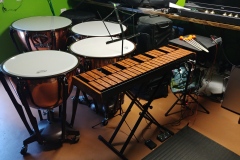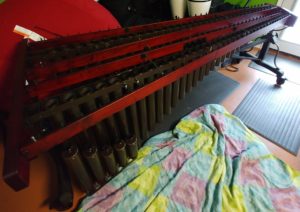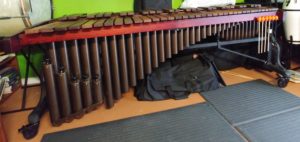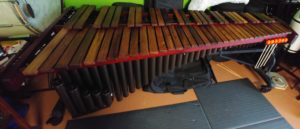Back in January, before the rona times, I acquired my first MIDI instrument, a Wernick Xylosynth Mk6. This one is 3 octaves (F – F) with Bubinga bars and built-in internal sounds. I’m not exactly sure the history of this instrument, but I think it was a floor model. It does not have some of the latest features: No USB power or USB communication, so I had to buy a MIDI-to-USB Interface separately, and I have to carry around the power supply.
I purchased this instrument because I wanted to use it in theatre shows. The last show I did was in December. It included chimes and vibraphone parts. I wasn’t able to fit chimes. I was able to use a real vibraphone, but I wasn’t able to rehearse with one. An instrument like this could have been pretty useful. I was also going to use it in the canceled Pensacola Bay Concert Band 5th anniversary concert, which would have happened in May. There was one song with piano and harp parts which I had been rehearsing on the Xylosynth.
The internal sounds on this instrument are not all too good. They’re fine for practicing or rehearsing, but most of them really don’t sound very realistic. Although, in truth, most synthetic instruments I hear in modern music sound pretty fake. However, if I connect it to my MacBook Pro and use MainStage 3, it has much better voices. The instrument is a breeze to play on. The Bubinga wooden bars feel just like the real thing. I purchased a sustain pedal (Nektar NP-1) that connects directly to the Xylosynth, and I also purchased a Logidy UMI3 foot controller. The Logidy connects to my computer and lets me use 3 customizable foot buttons. I’ve programmed them to change instrument voices, or to toggle vibraphone fan effects, or to change octaves. It also has a port for an expression pedal, which this model Xylosynth doesn’t have. I haven’t found any use yet for an expression pedal, so I’ve not purchased one.
I’m really hoping to be able to use this in a show at some point… In truth, I don’t actually like synthetic/electronic instruments; I prefer real instruments. I would also like to figure out a different live-performance solution that doesn’t involve me bringing my large, expensive MacBook Pro. Maybe something involving a Raspberry Pi and a small touch screen, but I don’t want to make many compromises in the sound quality of the voices. I need to look into it more.
Back in May, I used the Xylosynth to create a layered recording. One of the issues I noticed while stacking the layers is that there is a slight input delay between striking the bar and the Mac sending the sound to the amplifier, about 0.1 seconds. I don’t think this would be noticeable in a live performance, but my mic picks up the sound of the mallet strikes along with the actual amplified voice. When stacking, I aligned with the actual sound.

You can listen to that recording here. The marimba playing in this song is actually the Xylosynth.
All of my instruments are paid off… or at least they were…
I purchased a new marimba… from the same music store I purchased my vibraphone and many other instruments. My other marimba, the 4 octave C3-C7, Musser M32, with non-graduated padouk bars, which I was given while I was a sophomore in high school in 2000, is a great instrument, and I love it. It is fairly portable, and I use it in the Pensacola Bay Concert Band. However, a problem I have always had with it is most marimba solo music is written for at least 4.3 octave A2-C7 marimbas. I considered getting a 4.3 octave marimba, but ultimately decided if I did, I’d just wish I had a 5 octave, so I got a 5 octave.
Some ancient history, my middle school had chimes, bells, and a F4-C8 xylophone. My high school (when I started) had very run-down chimes, 3 bells, 2 [spray painted] F4-C8 xylophones, and 1 [spay painted] C5-C8 xylophone. After I very briefly used my marimba at school, they purchased their first A2-C7 marimba my junior year, and their first F3-F6 vibraphone my senior year. I was my school’s first 4-mallet player and first jazz band mallet player. Mallet percussion and indoor percussion were only just starting to catch attention at my high school toward the end of my time there… Too bad for me, I guess. They didn’t start purchasing more marimbas (and larger sizes) until after I graduated. The marimbas at Pensacola State College / Civic Band were also A2-C7. All that to say, I’ve never actually seen a 5 octave marimba in person, and I didn’t even know 5.5 octave marimbas existed until recently. [And they seem so impractical for field use.] I didn’t quite realize/picture how large this instrument is. It is huge… like 8.5 feet long.
The instrument was delivered by the store’s full sized piano van, just as my vibraphone came in Dec. 2015. It came in five [heavy] boxes.
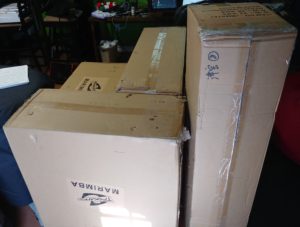
Basically, if I recall correctly, a box contained (1) all the bars, (2) the frame legs and knobs, (3) the frame rails, (4) two lower bass resonator pieces, and (5) two middle and two upper resonator pieces. When I finally got everything unboxed, this was all the cardboard and plastic…


Getting those boxes out of here will be a bit of a chore on its own…
Okay, so assembly… Do as I say, not as I do; Don’t try to assemble a 5 octave marimba alone. You won’t have a good time [and I did not]; you might get hurt [and a got a little sore afterward]; and you might damage your marimba [but I did not].
The first… problem… I had was there was absolutely no manual or instructions. There was one small cart written in traditional Chinese characters, which I figured out was a warrantee card only valid in domestic China.
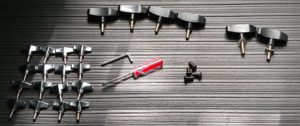
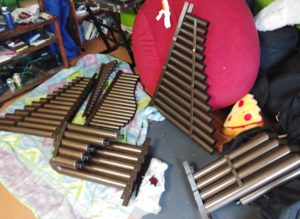
Please ignore the clutter and the pizza squishable cameo.
Here are some pictures I took along the way of the assembly.
And here it is when I finished… it took me about 2.5 hours to unbox and assemble…
I was curious as to what I actually purchased, as it is not entirely clear from the music store. I was able to find the manufacturer in China and learn more about it. Apparently, my vibraphone and this marimba were made by Jinbao Musical Instruments. My vibraphone is model JBVP1137. This marimba is model JBMA761M. It does claim to be Honduran Rosewood, but that does seem a little hard to believe, and I do not know how I would confirm that. It does sound much better than my other marimba though.
We won’t talk about how much I paid for this here…
I’ve seen some twitch streamers perform live music on Twitch, and I’ve been considering doing something similar. Maybe trying to play individual layers of various game music on different instruments and putting them together. That seems like a way to get some of my music/performance itch scratch without worrying too much about DMCA. I am just not sure anyone would watch.
I’ll have to write a separate rona update later…
